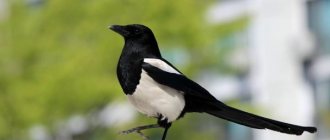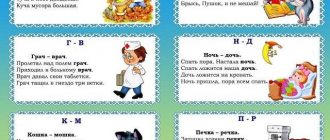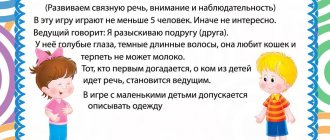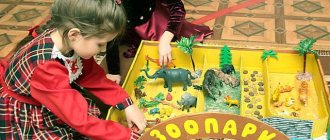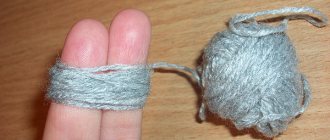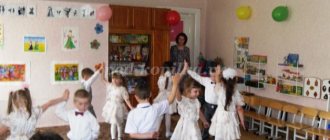Conversation “Uncharted Space”
author: Kireeva Veronika Nikolaevna
Teacher of MBDOU "Kindergarten" Rainbow "combined type" JV "Kindergarten No. 4 combined type" Ruzaevka
Conversation “Uncharted Space”
Conversation on the topic “Cosmonautics Day”
Prepared by: Veronika Nikolaevna Kireeva
Second junior group
Goal: acquaintance with space, the first cosmonaut.
Tasks:
Educational: to form children’s understanding of planet Earth, to introduce the first cosmonaut Yu. A. Gagarin.
Developmental: expand children’s ideas about the profession of an astronaut pilot, stimulate the development of speech, memory, thinking, develop imagination and fantasy.
Educational: to instill respect for the profession of an astronaut, to teach respect for planet Earth.
Progress of the conversation:
(The teacher starts the conversation)
Earth is the planet on which we live, it is the only planet in the solar system on which life exists. People, plants and animals live on Earth because there is water and air. It revolves around the Sun and is the most beautiful and interesting of all the planets. The Sun is the closest star to Earth. Without the Sun there would be no life on Earth. Everything that happens on our planet is connected with the Sun: the change of day and night, the onset of winter or summer. During the day, the sun warms and illuminates our planet. All living things rejoice in sunlight and warmth. With the sunrise, nature awakens and comes to life.
In the evening we can see the moon and stars in the sky. The Moon is the Earth's satellite. It shines brightly in the night sky. People have always wanted to visit the moon, fly to the stars, and see the Earth from space.
— Would you guys like to become astronauts?
—Who are astronauts?
-What do you think an astronaut should be like? (healthy, strong, knowledgeable, hardworking, courageous, resilient, etc.).
-What can you see in the sky? (stars)
- How many stars are there in the sky? (so many)
People wanted to know if there was life on other planets. What creatures live there, are they similar to us, is there air on other planets. But to find out, you must fly to them. Airplanes were not suitable for this. Who knows why? (because the planets are very far away). And so scientists invented the first satellite, installed instruments on it and launched it into outer space. There were two dogs on board - a squirrel and an arrow, they successfully returned to Earth. And then in 1961, the first man went into space.
The first person who was able to go on a space journey was cosmonaut Yuri Alekseevich Gagarin. He made his flight on April 12, 1961 on a Vostok rocket. On this day our country Fr. This is a holiday of astronauts and people who participate in the creation of space rockets.
Physical exercise "Rocket".
One, two - there is a rocket (hands up)
Three, four - airplane (arms to the sides)
One, two - clap your hands
And then on every account.
One, two, three, four - and they walked around in place,
Tick-tock, tick-tock - all day like this (hands on waist, bending to the side)
Didactic game “Family of Words”.
Let's play and form words from one family for the word "star".
- How can you affectionately call a Star? (star)
- If there are many Stars in the sky, then we will say what it is like? (stellar)
- What is the name of the ship that flies to the stars? (starship)
- What do they call a wizard in fairy tales who predicts the future from the stars? (astrologer)
Well done! Today you have learned a lot about space, astronauts, about our planet, and I think that you can be enrolled in the cosmonaut corps.
Summary of the conversation.
Questions:
- What is the name of our planet?
- What is the sun for?
- When can we get a good look at the moon?
- What was the name of the man who first flew into space?
Conversation “Uncharted Space”
Progress of the lesson:
Since ancient times, people have looked at the sky and thought about how to rise above the clouds and find out what is there. It took a long, long time before people learned to build healing devices. And the first to fly into them were not people, but animals: rats, and then dogs. Take a look at this picture. (Show). On it you can see the first dogs. Who flew into space and came back. Their names are Belka and Strelka. And only after other dogs had successfully flown into space did the first man go there. Many years ago, it was on this day that cosmonaut Yuri Gagarin flew into space. (Display of a portrait of Yuri Gagarin).
In a space rocket called “Vostok” He was the first on the planet to rise to the stars.
Since then, on this day every year we celebrate Cosmonautics Day - a holiday of astronauts and everyone who helps them fly successfully into space.
Today you and I will play as astronauts: we’ll go on a flight in a spaceship, help aliens, and observe the constellations.
Yuri Gagarin flew into space on a rocket. Using the example of a ball, I will show you how a rocket flies.
The teacher inflates the balloon and closes the hole with his fingers. And then he unclenches his fingers and the ball shoots up sharply.
Our balloon flew like a rocket - it moved forward as long as there was air in it. But the rocket contains not air, but fuel.
Now let's build our own rockets from geometric shapes.
Didactic game “Build a rocket”
Children are offered a sample and a set of geometric shapes. From which you need to build a rocket.
Dynamic pause “Cosmonauts land on planets”
Hoops of different sizes and sizes are laid out on the floor. Children are divided into two teams “Vostok” and “Molniya” and follow the commands: Crew members of the spaceship “Vostok”, line up one behind the other. Crew members of the spaceship "Molniya", stand in a circle. The crew of the Vostok spacecraft landed on the large yellow planet. The crew of the spaceship "Molniya" landed on two small blue planets.
Astronauts and scientists have found that there is no life on the planets that revolve around our Sun: some are too cold, others are too hot. Nobody lives on these planets.
Only our planet Earth is suitable for habitation in everything. After all, the Earth is a garden planet in this cold space. Only here the forests are noisy, calling migratory birds. Take care of your planet - After all, there is no other like it!
But maybe somewhere far, far away, near another star. There are living beings on distant planets. We call those who live on other planets “extraterrestrials.” Now the aliens need our help: we need to help them find their spaceships.
Didactic game “Place aliens in spaceships”
Take a look at the sheet and answer me, children: Who flies which rocket?
On a sheet of paper, aliens are drawn from geometric shapes and rockets in the shape of the same shapes. You need to connect with a line the images of a rocket and an alien, consisting of identical geometric shapes.
Over the Earth late at night, Just stretch out your hand, You will grab the stars: They seem nearby. You can take a Peacock feather, touch the hands on the Clock, ride a Dolphin, swing on a Scale. Over the Earth late at night, If you look into the sky, You will see constellations hanging there like grapes.
Didactic game “Name the constellations”
Guys, astronomers - scientists who observe and study stars - have discovered new constellations in the sky and ask us to help come up with names for them. Place your hands in a tube behind each other, as if looking through a telescope, and look carefully at this constellation. What can you call it?
House Bird Umbrella Flower
When we look at the sky at night, what do we see? (Show the picture. Children's answers). Stars and moon. The Moon is a satellite of our planet Earth.
Only the sun goes to bed, the moon cannot sit still. At night it walks across the sky, dimly illuminating the earth.
Now our rocket will go to the Moon. There we will draw a lunar portrait. But first, let's prepare our fingers.
Finger gymnastics
"Sun"
(Two palms connected crosswise to each other with fingers spread apart)
"Rocket"
(Palms connected with index, middle and ring fingers, lower parts of palms apart, wrists on the table)
"Lunokhod"
(Run your fingers over the surface of the table, avoiding all the irregularities, sideways, like a “spider”)
Goals:— expand children’s ideas about space flights: introduce them to Russian scientists who were at the origins of the development of Russian cosmonautics, — K.E. Tsiolkovsky, S.P. Korolev;
— consolidate children’s knowledge that the first cosmonaut on Earth was Russian citizen Yuri Gagarin;
— bring to the understanding that only a healthy, educated, persistent and fearless person can be an astronaut;
— to educate children to be proud of their country.
Materials and equipment:
— photographs of cosmonauts, Russian scientists;
— illustrations: “Start of the ship”, “Meeting of Gagarin”;
— photos of dogs — Belki and Strelki.
Educator.
The man looked at the starry sky and he wanted to know what kind of stars they were, why they were so bright? Scientists came up with special instruments - telescopes and, observing the starry sky, they learned that besides the Earth there are other planets - some smaller, others larger. What planets do you know?
The children answer.
Mars, Venus and many others. People wanted to know if there is life on other planets? And if there is, who lives there? Are these living creatures similar to people? But to find out about this, you need to fly to these planets. Airplanes were not suitable for this, because the planets were very far away. And scientists came up with rockets.
Who in Russia invented the first rocket?
The scientist and inventor Konstantin Eduardovich Tsiolkovsky lived in the city of Kaluga. (The teacher shows a portrait of a scientist.) He really loved watching the stars through a telescope, studied them, and he really wanted to find answers to the questions: “Is it possible to build a metal balloon that does not allow gas to pass through and floats forever in the air? Is it possible to fly to other planets using a rocket?” And he decided to design an aircraft that could fly to another planet. He carried out calculations, made drawings and came up with such an aircraft. But, unfortunately, he did not have the opportunity to do it.
And only many, many years later, another scientist-designer - Sergei Pavlovich Korolev (the teacher shows a portrait of the scientist) was able to design and manufacture the first space satellite, in which animals (dogs) first flew around the Earth, and then on April 12, 1961 he flew into space for the first time Human.
Who knows this man's last name? Who was the first astronaut on Earth?
The children answer.
It was Yuri Alekseevich Gagarin. (The teacher shows a portrait of Gagarin, the illustration “Start of the ship.”)
During the launch, flames broke out in the rocket engines; they all started working smoothly and simultaneously. The noise was incredible. But people still heard the kick, Gagarin laughed and said: “Let's go!” And at that same moment the rocket took off and disappeared into the blue sky.
Yuri Alekseevich was the first to see the whole Earth. (The teacher shows a view of planet Earth from space.) Not a piece, not a section, but all at once, entirely - from pole to pole. He flew and looked out the porthole window, and not just mountains and seas, and not just islands and continents floated under him, the whole planet floated and turned under him. In 108 minutes he flew around it. “How beautiful she is!” - Gagarin spoke on the radio to those who remained below.
What do you think an astronaut should be like?
Children's guesses.
First of all, an astronaut must have good health, he must be strong and resilient, because during a space flight a person experiences enormous overloads. Listen to what Yuri Gagarin felt during the world's first space flight. Writer Viktor Borozdin wrote about this.
The rocket rushed further and further from the Earth. Yuri Gagarin was reclining in a chair, unable to even move. The faster the rocket flew, the stronger the pressure on the chair.
The body suddenly became incredibly heavy. Arms, legs, every finger became not our own, as if cast from cast iron. Only a minute of flight passed, but it seemed to Gagarin that he had been flying for an hour. My chest felt tight and it became difficult to breathe.
And from Earth they were already asking on the radio: “How are you feeling?” You have to answer, but saying even one word is also not easy. It's hard to even open your mouth. And yet Gagarin found strength in himself: it was not for nothing that he trained so much before the flight.
“I’m fine, everything’s fine,” he said, “I’m flying normally.” I feel good.
The rocket was shaking. She seemed to be in a hurry to fly to the height that the scientists had indicated to her.
And suddenly it became quiet - the engine stopped working. But the ship was moving at great speed. The cabin no longer shook, and there was less and less pressure on the seat. Suddenly, Yuri felt that he was lifted above the chair, and his body weighed nothing. He raised his hand - it remained raised, raised his leg - it did not fall.
Gagarin wanted to write down his observations in a journal, looked, but the pencil was not there: it was floating around the cabin. He tossed the magazine and it hung in the air.
Gagarin didn’t want to eat or drink yet, but he had to try. After all, food in space also weighs nothing, and who knows if he will be able to swallow it? What if it gets stuck in your throat? On Earth I tried to eat upside down while standing on my hands. It worked. Well, what about here?
Gagarin’s food was special, “cosmic”. From a tube, the kind that toothpaste usually comes in, he squeezed the meat puree directly into his mouth. Swallowed it. Then I squeezed out fruit jam from another tube, and then currant juice. I swallowed everything. It was only when he was drinking juice that he accidentally spilled a few drops, and they floated through the air like black berries...
Educator.
You see how difficult it was for the first cosmonaut. Why do we say that an astronaut must be fearless?
Children's guesses.
Previously, people had never flown into space and did not know what they could encounter there. After all, there could be some malfunctions in the rocket. Therefore, when Yuri Gagarin first flew into space, all our people followed this flight, everyone was worried about the first cosmonaut. And when he landed safely, the whole country rejoiced. People took to the city streets. In Moscow, people gathered in the center, on Red Square, and this celebration continued until late in the evening. We were all proud that it was a Russian citizen who was the first in the world to fly into space.
The teacher shows illustrations of people on Red Square with posters: “Hurray! Gagarin", "Glory to our Motherland!"
After Gagarin's flight, a lot of cosmonauts visited space, including women - the world's first female cosmonaut Valentina Tereshkova and Svetlana Savitskaya. (Shows portraits.)
What astronauts' names do you know?
The children answer.
Alexey Leonov is the first cosmonaut to walk into outer space. (Shows the portrait.)
Many cosmonauts flew into space more than once and worked there for several months. Currently, joint flights are being carried out with cosmonauts from different countries.
Our country appreciated the work of astronauts: all cosmonauts were awarded high awards.
But people don't stop there. They strive to explore everything distant and unknown - new planets and starry distances.
Maybe one of you will also become an astronaut or rocket designer, invent a rocket on which people can travel long distances and discover new planets.
